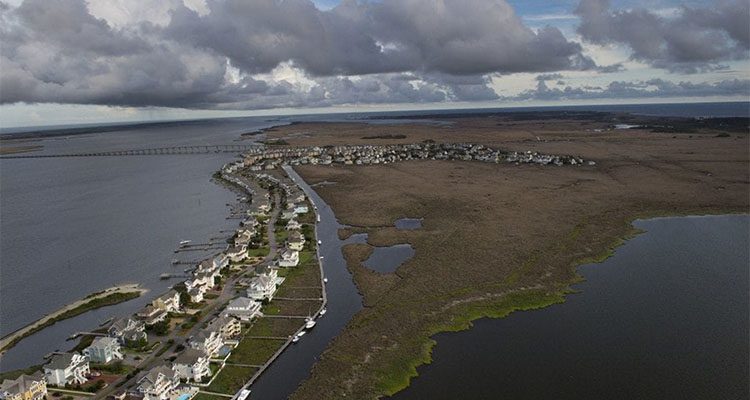
Roanoke Island, shown in the foreground in this aerial view of the Outer Banks in North Carolina, on June 12, 2014, was the site of the “lost colony” where Virginia Dare was born more than 400 years ago. (Nikki Kahn/The Washington Post)
Virginia Dare and the myth of American whiteness.
With Confederate statues toppling while President Trump taunts Sen. Elizabeth Warren as “Pocahontas,” it’s clear that our nation’s current divisions reach deep into our shared past. But one of the strangest of those battles is over a baby born on a remote North Carolina island more than four centuries ago.
Like Robert E. Lee or Pocahontas, Virginia Dare is as much mythical as she is historical. The first English child born in the New World, she is famous for vanishing along with the other 115 colonists at Roanoke Island who made up England’s first attempt at settling the New World. Less well known than her disappearance, though, is her persistence as a potent symbol of white supremacy. Unlikely as it may seem, the story of this innocent child, about whom we know little more than a name and date of birth, provides a surprising window into the origin of our current national anxieties about race, gender and immigration.
For two-and-a-half centuries after the colonists vanished, the failed Roanoke venture was largely forgotten. Then, in 1834, Harvard historian George Bancroft wrote a best-selling work that cast the botched effort as a romantic mystery. He also resurrected “the first offspring of English parents on the soil of the United States.” Female writers, eager for inspiring women and girls from the country’s past, seized on this brief mention. In an 1837 magazine story recently unearthed by English professor Thomas Shields, Eliza Lanesford Cushing coined the term “Lost Colony” and created the legend of the fair-skinned Virginia dazzling the swarthy Indians with her beauty and skill. But Virginia remained chaste, keeping their “uncontrolled passions” at bay.
The story spawned a genre, one perfectly suited for an era in which white Americans felt under threat from outside forces. In the 1830s, an influx of non-British immigrants alarmed white Americans and a mercurial president, whose promise to clean up Washington split the country in two with his radical policies. Race relations were volatile and violent; tens of thousands of Native Americans were forced west while Nat Turner led a slave rebellion that was brutally suppressed. The plight of an innocent white girl wandering the dark forest among lusty savages spoke to Americans who worried that people of British heritage were losing their grip on the young republic. Soon, newspapers were referring to “the first Anglo-American, Miss Virginia Dare,” and legends proliferated of her forest life as a kind of American Artemis.
Her popularity spiked again at the turn of the 20th century, when more than 1 million immigrants each year flooded into the United States, prompting white fears of “race suicide.” (Italians and Jews, who made up the bulk of the new arrivals, typically were not considered white.) In a 1901 best-selling poem, an evil Indian shaman — one of the “slaves of superstition” — turns Virginia — the “heir of civilization” — into a white doe. She eventually dies a tragic death to pave the way for British domination of the savage continent.
Not coincidentally, this also was heyday of Jim Crow in the American South; the following year, Virginia politician Carter Glass backed his state’s plan to eliminate black people as a political factor and thereby ensure “complete supremacy of the white race in the affairs of government.” He went on to become U.S. treasury secretary. At the 1907 exposition celebrating Jamestown’s 300th anniversary, Virginia Dare was hailed in the North Carolina exhibit as that “infant child of pure Caucasian blood” who launched “the birth of the white race in the Western Hemisphere.”
Her birthday celebration on Roanoke Island became an annual ritual to reinforce Anglo-American power. At the 1910 gathering, North Carolina’s Episcopal bishop urged the crowd to forget the idea that the Lost Colonists mixed with Native Americans rather than starve, which is what most historians today say was the most likely outcome. They would, he insisted, have endured “a nobler fate” — martyrdom — rather than choose survival with barbarians. Marrying outside one’s race, in North Carolina and throughout the South, had long been illegal. Better to die than assimilate.
The myth of the independent and resourceful child of Roanoke also gave courage to suffragists, who often mixed claims of white women’s superiority to black men into their fight for the vote. Gertrude Weil, a progressive Jewish activist in North Carolina, tried to convince white male legislators in 1920 to give women the franchise. But she knew the all-white and all-male legislature would never support empowering black women. To assuage their concerns, she printed a broadside for lawmakers that read, “We plead in the name of Virginia Dare, that North Carolina remain white.”
Even now, white supremacists and their allies claim Virginia Dare as their own. Peter Brimelow, a friend of former White House aide Stephen K. Bannon and current White House adviser Stephen Miller, founded the Vdare Foundation and vdare.com in 1999 to warn Americans about the danger posed by African and Asian immigrants.
“I picked the name because I wanted to focus attention on the very specific cultural origins of America, at a time when mass nontraditional immigration is threatening to swamp it,” he wrote me. Brimelow originally is from Britain. One of his website’s postings notes that the Lost Colonists “simply found themselves outvoted, which is going to happen to us if we are not careful.”
Others draw a different conclusion. Behind the tales of a white girl in doeskin is a deeper truth about immigration. “New Americans step up to become the most American,” says North Carolina writer Marjorie Hudson, who authored a book about the Virginia Dare myth. “It is time to let go of some of the childish thoughts about how this country was formed,” she argues. “Our country’s past is no more pretty than any other country’s wayward history.”
Virginia Dare’s story reveals our desire to assimilate and our anxiety about doing just that. This conflict is at the root of the cultural battle that led to violence last summer in Charlottesville, as white Americans confront the growing numbers of black and brown people with whom they share a country. The infant of Roanoke offers us two very different futures. We can be martyred for some imagined race, or we can recognize that to be American is, in its essence, to be willing to redefine our beliefs, goals and even our ethnicity. Only by getting lost can we become something new.
